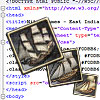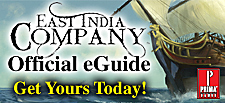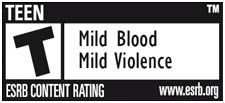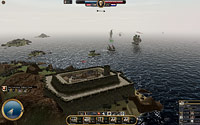- Übersicht
- East India Company
- Pirate Bay
- Privateer
- Designer's Cut
- Battle of Trafalgar
- Collection
- Die Schiffstypen
- Entwickler-Blog
- Videotagebucheinträge
- Modding-Anleitungs-Serie
 09 Oktober 2009:
09 Oktober 2009:Modding Teil 6.
This time we learn how to translate the East India Company to your own language.
Weiterlesen » 15 Juli 2009:
15 Juli 2009:Naval warfare, part II.
Lead designer Kim Soares takes the helm of a frigate and shouts: "Port side, FIRE!"
Weiterlesen »
 Halten Sie sich über East India Company auf dem Laufenden: Abonnieren Sie den Newsletter. (Nur in Englisch)
Halten Sie sich über East India Company auf dem Laufenden: Abonnieren Sie den Newsletter. (Nur in Englisch)
E-Mail-Adresse:
 Abonnieren Sie jetzt den Paradox-Newsletter und erhalten Sie alle aktuelle Informationen von Paradox Interactive (Nur in Englisch).
Abonnieren Sie jetzt den Paradox-Newsletter und erhalten Sie alle aktuelle Informationen von Paradox Interactive (Nur in Englisch).
E-Mail-Adresse:


Designer's Blog: Circle of money and war

Welcome to the first ever East India Company designer's blog!
First, let me introduce myself. My name is Kim Soares and I am the lead designer of East India Company. In these designer's blogs I'll try to give you some insight into EIC that you can't read from anywhere else.
I think that best first subject would be the whole high concept of the game. We can go into more detail from there in
later blogs.
One major reason why we ended up doing EIC and not, say sport game or shooter was the fact that history of east India
companies just cried out to become depicted in a game.
Commerce and warfare are recurring themes in games, but rarely, if ever, these two themes are as closely combined as
in EIC. Many strategy games have modeled commerce in some way: Settlers, Hearts of Iron, Warcarft, Age of Empires...
Tycoon games are commercially oriented, but you rarely actually concentrate on trading in them. Rather you run business
of some sort, be it a zoo or railroad company.
In East India Company however, trading is the goal of the whole game: In campaigns your goal is to lead your company to
dominate all trade from East Indies. Everything you do is just means to this end. Of these means, warfare is the most
dramatic.
Waging war is very expensive, which creates an endless circle: to beat other nations economically, you need to wage wars,
and that requires lot of funds that you get from commercial success.

Protect your traders
To be able to trade from East Indies, you naturally need ships. There are eleven ship types altogether: five trading ships
and six warships. Although trading ships are armed to some extent, they are no match to warhips of other companies or to
pirates.
So, the first step on the road to becoming a military might is to buy some warships to protect your traders. All your ships
are organized into fleets. You can have a maximum of twenty fleets and each fleet can have a maximum of five ships.
In order to protect your trading ships you can create mixed fleets that have both ship types in them. Other possibility is
to create fleets of wa
rships that you then assign to escort trading fleets. If a fleet with escort is attacked, attacked
party can choose to fight the attacker with the escorting fleet instead.

Ports are key element
Ruling ports is extremely important. This is because of two things. First, the Main Trade Items or MTI's, i.e. the items
most valuable, can only be found in certain ports. Spices for example are only produced in Surat, Bombay and Goa. Ports
ruled by companies are off limits to other companies and they are not able to acquire any trade items from those ports.
Ports that do not have MTI's have secondary trade items, but their real value is in their ability to supply fleets. All
fleets have limited range and they have to regularly visit ports to automatically replenish this range. This represents
the fact that ships had only limited supplies of food and fresh water. If you are unable to visit ports to supply your
fleets, you can find yourself effectively cut off from the East Indies.
These two facts make ruling the ports so important.
Ports can be taken over by simply attacking them with fleet of ships. It helps a lot if the fleet is transporting marine
detachments. When you have a port under your rule, you can start upgrading buildings inside. It is worthwhile to upgrade
fort and barracks, as you can expect your rivals to pay you a visit sooner or later.
All this military power costs money. To afford it you have to trade successfully. And to trade successfully you need military
power. Welcome to the world of East India Company!
That's all for now, I'll keep you posted with more Designer's blog entries soon!







